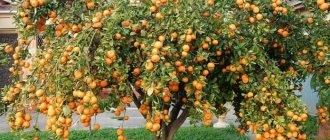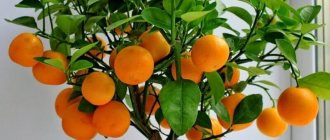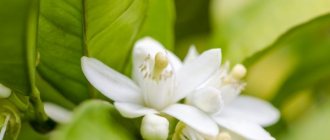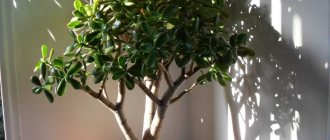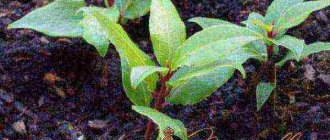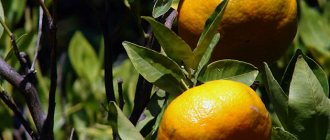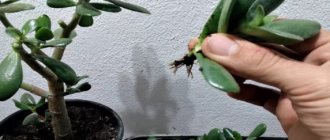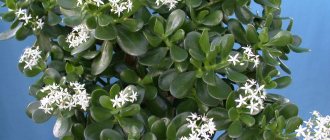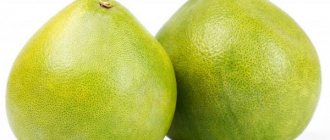Description of indoor tangerine
Belongs to the category of evergreen trees. Under natural conditions it grows up to 4 m. The length of domestic plants rarely exceeds 1 m.
The northern part of India is considered the birthplace of tangerines. A wild form of the plant is sometimes found in forests. Several thousand years BC. they acquired a cultural appearance. In the 12th century, the tree migrated to China and then to Japan. The fruit appeared on European territory a little over 150 years ago and quickly gained popularity. In addition to eastern countries, major global producers are Brazil and Spain. High demand is due to the early fruiting of trees and sweet fruits.
India is considered the birthplace of the mandarin
Options for the origin of the name:
- Initially, the island of Mauritius, where tangerines grew, was called Mandarin.
- During the era of world exploration, the Portuguese called the dignitaries of the highest echelon of power this way. The word was coined from the Mala "mantri" which means "minister". This plant was very popular in China. It was even offered in the form of bribes to officials.
- Translated from Spanish, “mondar” means “to peel.”
The aroma of tangerines relieves stress and has a sedative effect
Main characteristics
Along with orange and lemon, it is considered one of the most popular citrus fruits in the world. However, it has a more pronounced smell and sweet flesh.
Table 1. Main characteristics of mandarin
| Plant part | Description |
| Crown | Round in shape, spreading, in its natural environment grows up to 3.5 m. |
| Branches | Mostly drooping. |
| Leaves | Small, rich green in color, leathery, dense in texture. The petioles have small wings. The shapes are both ovoid and pointed. The lifespan of a leaf is from 2 to 4 years. |
| Bark | Dense, light gray in color. |
| Flowers | White, located in leaf axils. Depending on the variety, they can be single or paired. The aroma is similar to the smell of bergamot. |
| Fruit | The diameter reaches from 4 to 6 cm, weight - from 30 to 100 g. The shape is flattened. |
| Seeds | The fruit contains up to 12 segments, each with 1 to 2 seeds. There are seedless varieties. |
| Pulp | Light orange in color with sacs filled with juice. |
| Peel | Orange, not dense, quickly separates from the core. |
The tree looks elegant when flowering
Features of fruiting:
- The culture is self-fertile.
- Belongs to the category of precocious. The first harvest is taken in the 3rd year of plant growth.
- Fruits are set both on old growth and on fresh growth.
- The plant blooms once in the spring.
- The fruits ripen by October. The harvest ends in December.
Mandarin grown indoors produces 40 to 50 fruits annually. As the tree grows, their number increases.
The average lifespan of a tangerine tree is 70 years
Composition and positive effects on the body
The calorie content of the fruit is 53 kcal per 100 g.
Nutritional value (g):
- fibers - 1.8;
- carbohydrates - 13.3;
- proteins - 0.8;
- fats - 0.3;
- water - 85.2.
In winter, tangerine is considered one of the main natural sources of vitamins
Table 2. Useful properties
| Piece of fruit | Characteristics |
| Pulp | A storehouse of vitamins E, A, C, group B, minerals, phytoncides and organic acids, including citric acid. It has bactericidal properties and improves appetite. |
| Bones | B vitamins prevent strokes and heart attacks. Vitamin A reduces the risk of skin pathologies. Sodium and potassium have a positive effect on the functioning of the cardiovascular system. |
| Peel | Carotene and esters improve peristalsis and digestive processes. Glycosides strengthen the walls of blood vessels. |
| Seeds | Polyphenols prevent the formation of malignant tumors. |
The nutrient-rich composition of tangerines has a beneficial effect on the functioning of the human body.
Mandarin varieties
There is still no one specific classification of tangerines. There are 7 main groups of this plant:
- satsuma, or unshiu mandarin, a low-temperature-resistant plant, is actively grown in Europe and Russia. The tree in nature grows up to 3 meters in height and up to 1.5 meters in indoor conditions. At the 3rd year of life, it begins to produce round, flattened fruits with a thin, easily peeled yellowish peel. There are no seeds in the pulp.
- Sitrus deliciosa, oval-flattened fruits with orange skin;
- Citrus ostere, fruits with rich red skin, sweet, easy to peel and slice;
- Sitrus reticulata, large orange fruits, oblong or round in shape, sometimes with a navel. The peel is slightly thick and can be easily removed. The pulp is sweet and juicy, with a large number of small seeds;
- royal (noble) mandarin, large fruits with thick wrinkled skin and very sweet pulp;
- the group of small-fruited tangerines includes the varieties Kishiu, Mukaku-Kishiu and Shiwamican;
Hybrids include a large number of varieties that have been developed by crossing mandarin oranges with other citrus fruits. Hybrids include rangpur, calamondin (citrofortunella), tangelo, thornton, tangor, mineola, ellendale, mandora, citrandarin, agli, santina, ichandarin, sudachi, yuzu, kabosu, Meyer lemon, bitter orange, orangequat and clementine, which in turn is divided into 3 main types: Montreal, Spanish and Corsican.
Peculiarities of tangerine reproduction
Mandarin, like other citrus fruits, reproduces by seed and vegetative methods.
Citrus seeds are typically obtained from fruits purchased at grocery stores. But the fruits of seedless hybrids often appear on the shelves. This makes it difficult to obtain planting material.
Most gardeners propagate tangerines vegetatively. Obtaining air layering is a labor-intensive process that is only possible if there is an adult tree suitable for this procedure.
You can get a cutting from a plant that bears fruit. However, rooting a tangerine is difficult. Often, the seedling does not form roots, but experienced gardeners say that successful plantings do occur.
The most common method of propagating tangerine is to graft a cutting onto a lemon or orange rootstock. We are not talking about a lemon tree that will have only one branch with orange fruits. In this case, the trunk of the mother plant is used, onto which a tangerine cutting is grafted. A plant grafted in this way becomes a full-fledged tangerine.
Mandarin belongs to the Rutaceae family. Homeland - Southeast Asia.
The tangerine got its name because its delicious fruits were the privilege of the Chinese emperors - tangerines.
Mandarin also occupies an important place in the ancient oriental art of Feng Shui. The tangerine tree symbolizes good luck in receiving money, and also has the ability to activate existing savings
A beautiful small tree that blooms and bears fruit every year will certainly delight the eyes of the owners and surprise guests with its exotic appearance.
There is very little information about the origin of mandarin. It is believed that its homeland is China or Japan. It was brought to Europe from Southeast Asia only in the last century, but it quickly spread throughout the Mediterranean. Now tangerine plantations are especially large in Japan, China, countries of Southern Europe and South America. More than 6 million tons of tangerine fruits are harvested annually. In terms of production volume among citrus fruits, tangerine ranks second after orange.
Tangerines grow on low trees with a spreading crown. Their leaves are very smooth, shiny, green at any time of the year. The fruits ripen quite quickly and can be harvested already in November. Tangerines produce the largest harvest among citrus fruits. In favorable years, 5–6 thousand fruits are collected from one tree per season.
In the subtropical regions of the Russian Black Sea region, tangerines can be grown, but there is no free space for planting large plantations here. Tangerines are found only in the individual gardens of local residents. This citrus comes to Russian cities mainly from neighboring countries: Abkhazia and Adjara.
Below we describe what a tangerine tree looks like and how to grow a houseplant at home.
How does tangerine grow in nature?
In nature, it grows in the form of a small tree with a height of 2 to 4 m. The plant’s homeland is Southeast Asia. Tangerines ripen slowly - on average about 9 months. On plantations, up to 50 kg of delicious sweet fruits can be harvested from one tree.
Indoor tangerine
The leaves of the plant are oval-shaped, somewhat pointed, dense, with a strong skin. Throughout the year, their green color does not change.
Interesting. Each leaf lives on average about 4 years.
The trees bloom during February - April. The fruits ripen by November-December. In the tropical zone, flowering continues several times a year.
Mandarin in nature
Mandarin is the most frost-resistant. The most cold-resistant varieties can withstand temperatures down to 8 degrees below zero. In severe frosts, the plant dies.
If a lover of indoor plants decides to grow a tangerine tree, caring for it at home will not be difficult.
Soil for planting tangerine
When preparing a substrate for sowing or transplanting a tangerine, you need to take into account its age. A young plant needs a slightly different soil composition than what is suitable for an adult, fruit-bearing tree. The best option may be purchased soil for roses or vermicompost. These nutrient mixtures are quite permeable and fertile.
Orlando is an ideal choice for homeowners to use. It is cold hardy and produces high quality fruit that ripens early. Other early season tangerine hybrids that can be grown include Lee, Robinson, Osceola, Nova and Page. All of these hybrids require cross-pollination for best fruiting. Sweet oranges can be grown along the lower riparian zone with a fair degree of success if sufficient protection from cold is provided each year. Hamlin is suggested if the fruit is desired primarily for juice.
You can make a soil mixture to plant a tangerine tree in it yourself. To sow seeds and young seedlings in the first 3 years of life, you need to take the following components:
- leaf soil - 1 part;
- turf soil - 2 parts;
- fine river sand - 1 part;
- compost or humus - 1 part.
The resulting mixture must be poured into containers on a drainage layer of crushed stone or broken brick. Light soil allows the young plant to actively develop the root system. But an older tree will require a different soil composition:
Its cold tolerance is equal to or superior to other sweet orange varieties; however, a hard freeze will cause significant damage. The fruits are commercially seedless and ripen early. Sea orange is recommended for growing seedless fruits that will be eaten fresh. Navel oranges often produce light crops and are often as fruitful as sweet orange varieties such as Hamlin. Varieties offered include Washington, Dream and Summerfield. All their fruits ripen relatively early.
Due to its lack of outstanding cold tolerance, grapefruit should be grown along the same lower riparian zone as sweet oranges. Although there are numerous varieties to choose from, the most commonly planted varieties are Marsh and Redblue or Ruby.
- leaf soil - 1 part;
- turf soil - 3 parts;
- sand or ASG - 1 part;
- humus - 1 part;
- fatty clay - 0.5 parts.
This composition involves obtaining a more dense soil in which moisture is retained longer. This allows the plant to more fully utilize the nutrients necessary for the formation of buds and fruits.
There are a variety of hard acid oil fruits available for homeowners to use. These plants make attractive ornamental specimens and provide delicious fruit. All are self-sufficient and do not require cross-pollination. Kumquats are the most cold-hardy of the commonly grown acid citrus fruits, withstanding temperatures up to 15-17 degrees Fahrenheit. They have a slow regrowth rate in the spring, which helps avoid late frost damage. Kumquat is one of the most widely used citrus plants around the home and grows into an attractive shrubby tree that bears small orange fruits about one inch in diameter.
Temperature and watering the plant
Have you placed a tangerine on the windowsill? Then in winter you should take care of it by properly insulating the window. They also insulate the pot with the tree itself.
In order for the tangerine to shoot buds and bloom, it is important to maintain the temperature to 18 degrees. There must also be suitable humidity - 60%
At the same time, you should not be afraid of high temperatures, because the plant has the ability to withstand up to 40 degrees of heat.
Now let's move on to the basics of watering. As the top layer of soil dries out, it is necessary to water the plant. Under no circumstances should the lump of earth dry out in the pot. Every day, determine how wet the soil is by testing the surface layer of soil with your fingers. If during the inspection you notice that the soil sticks together, then it does not need watering, but if it begins to crumble, then watering is required.
Especially in the summer, it is important to monitor the condition of the soil. Indeed, due to the fact that the tree is exposed to high temperatures and bright sun, the soil often dries out
It is also worth remembering that not all water is suitable for irrigation.
If you have a city apartment, then the water from it is not suitable for watering tangerines. This is explained by the fact that it contains alkaline earth metals, as well as chlorine. Such substances will only harm the plant. As a result, its leaves will suffer from chlorosis, and metabolic processes in the soil will be disrupted.
It's a good idea to boil the water every time, but you probably don't need that much trouble. Another good option is to use hot tap water, which contains less chlorine and is also soft. Before watering the tree, leave the water in an open container for a day - then the chlorine will be completely removed from it. After all, this substance is destructive for any citrus fruit.
If you own a private home, then water from wells will do. However, the water found in a lake or stream is even better. Let it warm up a little at room temperature before watering. Rainwater is not suitable for irrigation, because it contains harmful impurities. What is the best way to care for tangerines in winter? Heat the water until it reaches 35 degrees. Then the tree will grow and bear fruit better. In summer, it is easier to deal with this issue by simply placing water on a window where there is more sun.
How to care for a tangerine tree
An actively growing and beautiful tangerine tree is the result of systematic and proper care. For an indoor ornamental plant, it is necessary to create comfortable conditions with a certain temperature and humidity level. We should also not forget about the peculiarities of watering, because... in a difficult situation, a bush can shed its foliage to reduce the amount of moisture evaporating from the surface. When the branches begin to bear fruit, they need to be tied to a support. We should not forget about possible pests and diseases.
Air temperature and humidity
The best temperature regime for a tangerine seedling is a temperature of +15-18 degrees in the warm season and +12 degrees in the winter. In hotter weather, the plant begins to bear fruit and bloom worse - buds and ovaries are poorly formed at this time
At the same time, it is important to avoid sudden changes in temperature, but in order for the plant to become stronger, it must be hardened, i.e. help him adapt to changes in lighting and temperature
To do this, in the spring during the day, briefly take the plant out onto a closed veranda or balcony.
Air humidity is also very important for tangerines. On hot, dry days and in winter, when heating dries out the air in the room, you need to frequently spray the ornamental plant - sometimes up to three times a day. You can place a bowl of water or some other air humidifier on the windowsill, for example, an imitation of a fountain or waterfall
When the bush begins to bloom, spray carefully to avoid moisture getting on the flowers and buds. It is better to replace this procedure by regularly wiping the leaves.
Illumination
Without enough light, a decorative indoor tangerine will not grow large. The easiest way is to place the container with the plant on the windowsill of the southern part of the house, but this is fraught with burns to the leaves. A more acceptable option is the side of the eastern or south-eastern windows. If the south side turns out to be the only possible choice, then in spring and summer you will have to shade the plant. In winter, the south window will be the best place for the seedling. When daylight hours become shorter, add artificial lighting using special phytolamps.
How to water indoor tangerine
The tree needs regular and frequent watering. In hot weather, water 2-3 times a day. In the winter, if good moisture is maintained, watering twice a week will be sufficient. It is better to first pour water for this procedure into a container, for example, a bottle, so that it has time to settle and warm up to room temperature.
With a short-term lack of moisture, the tangerine tree will not die, but it may shed some or all of its leaves. Fresh greenery will no longer appear in “bald” places, so try to avoid unexpected leaf fall. Leaves will appear only on new branches. Frequently transfusing the plant with water will not be beneficial either, because... this will lead to the appearance of fungal diseases.
Growing tangerine at home
Breeders have developed many low-growing varieties and hybrids designed specifically for growing at home. Some of them are more ornamental plants with inedible fruits, others not only look beautiful in the apartment, but also produce a good harvest of tasty fruits. The most suitable varieties for growing at home:
- forged-vase, a strong tree, grows from 80 to 180 cm, blooms profusely and gives a good harvest already in the 2nd year of life. Fruits with orange-yellow skin, sweet and sour pulp, without seeds;
- shiva mikan, a neat tree with dark green leaves. It blooms profusely, but there is a predisposition to the ovaries falling off. The fruits are small, up to 30 g, with a sweet and sour taste;
- unshiu, the tree grows up to 80-150 cm in height, produces flexible shoots that form a spreading crown. It bears fruit in 3-4 years of life, if provided with light in winter, it can produce crops all year round;
- clementine, a hybrid of orange and tangerine, bears fruit in the 2nd year of life and brings a good harvest, up to 50 fruits per tree;
- Murcott is a variety of tangor - a hybrid of sweet orange and tangerine. It produces sweet fruits called honey fruits. It grows into a compact tree and produces a harvest in summer. Seedlings are expensive, but are easily propagated by cuttings.
For planting, it is necessary to select even and thick seeds without damage or deformation. They need to be planted immediately before they dry out. The sooner the seed is in the soil, the more likely it is to sprout.
You can carry out the procedure of germinating seeds before planting. The bones are wrapped in gauze moistened with water. After a few days they will swell and begin to sprout. It is important that the gauze is always damp.
Tangerines do not like acidic soil, so peat should not be used for planting. It is recommended to use a purchased one with a neutral reaction. You can prepare the soil yourself: combine part sand with 2 parts humus and 2 parts forest soil.
The planting process consists of the following steps:
- Use shallow pots with a hole in the bottom or plastic glasses (250 ml). Plant 1 seed in each container;
- fill the containers with soil and plant the seeds to a depth of 4 cm. Germination time is 16-30 days, depending on the variety; if you come across multi-germ seeds, they can produce several sprouts, from which the weak ones must be removed. Maintain the room temperature within 20-25 degrees, make sure the soil is always moist;
- When the roots fill the entire container, replant the sprout using the transshipment method.
Until the tangerine begins to bear fruit, replanting should be done every year. Fruit-bearing plants are transplanted every 2-3 years into larger containers. Large and mature trees do not need to be replanted; you just need to remove the top layer of soil and add fertile soil.
And a little about secrets...
Have you ever experienced unbearable joint pain? And you know firsthand what it is:
- inability to move easily and comfortably;
- discomfort when going up and down stairs;
- unpleasant crunching, clicking not of your own accord;
- pain during or after exercise;
- inflammation in the joints and swelling;
- causeless and sometimes unbearable aching pain in the joints...
Now answer the question: are you satisfied with this? Can such pain be tolerated? How much money have you already wasted on ineffective treatment? That's right - it's time to end this! Do you agree? That is why we decided to publish an exclusive interview with Professor Dikul, in which he revealed the secrets of getting rid of joint pain, arthritis and arthrosis.
Tangerine trees are available for keeping even on windowsills. Specially bred dwarf varieties are exquisite and miniature, do not exceed 1 m in height, but are able to bear fruit abundantly. However, it is not so easy to grow a tangerine tree; caring for it requires certain knowledge and skills.
- “Unshiu”
is distinguished by its short stature and lush crown, consisting of many thin and flexible branches. The leaves are dense, dark green, the fruits are seedless and pear-shaped. It grows quickly and bears fruit readily. - “Kovane-vasse”
is a shrub with massive and stiff branches, the leaves are dense and fleshy, the fruits are bright yellow-orange in color. Even in an apartment it can grow more than 1 m. - “Murcott” (“Honey”)
is a not very common variety in indoor floriculture; it is distinguished by its small bush size and sweet, aromatic fruits, which is why it got its name.
Types and varieties for indoor growing
Money tree - home care and flowering
Species forms, hybrids, and various varieties of tangerines are grown in pots. Their height does not exceed 1.5 m, and the crown is formed into a tree or bush by pruning. It is not difficult to get them to bear fruit at home.
Calamondin
This is also the name of citrofortunella (lat. Citrofortunella microcarpa), a representative of the Rutaceae family. It is a hybrid of kumquat and tangerine. Its small dark green glossy leaves have a pleasant aroma. The abundantly flowering and fruiting tree thrives indoors.
Indoor calamondins
Homemade Pavlovsky
A remontant hybrid of tangerine and pomelo was bred in Pavlovo. A tree up to 1 m high blooms with large (up to 3 cm in diameter) flowers of 4-8 petals. The buds are pink-violet, and when fully bloomed they are white. The fruits are sweet, consist of 12 segments, with a total weight of up to 80 g and up to 7 cm in diameter.
Pavlovsk mandarin
Anniversary
A plant very similar to the classic orange. It is a hybrid of the Miagawa Washo variety of mandarin with an orange. Propagated by cuttings. The fruits ripen in October.
Kovano-Vase
The very popular variety all over the world, Kawano Wase (Cītrus unshiu Kawano Wase), is a mandarin orange belonging to the large unshiu group. The group includes the Vasya line, which currently includes 7 varieties, among which Kovano is the ancestor.
It has been cultivated in the USSR since 1937. The variety was created for pot cultivation and reaches full maturity in 3 years. A 5-petal flower up to 4.5 cm in diameter produces sweet large fruits of 8-13 segments, ripening in just 5-6 months.
Mandarin Kovano-Vase
Emperor
A popular decorative variety of indoor tangerine. Low trees readily bloom from the 3rd year of life. The plant produces abundant harvests from December to January. The fruits are covered with a thick, aromatic peel that is easily separated from the pulp.
Unshiu
A distinctive feature of the fruits of this variety series is the slightly flattened fruits, which may have no seeds at all or very few of them. The color of the peel and pulp is yellow-orange. The taste is sweet and sour. All representatives are cultivated on an industrial scale in Japan, and in our country - in Transcaucasia.
For your information! Almost all indoor tangerines that can be bought at garden centers are unshiu.
Mandarin variety Unshiu series
Imperial
It compares favorably with other indoor varieties in the size of its fruit. They grow up to 80 g in weight and have very sweet and tender flesh. Traditionally, ripening occurs in November.
Shiva-mikan
A very fast growing tree that remains compact. The leaves are large, dark green. The fruit is small in size and tastes sweet and sour. In indoor culture it is valued for its decorative value, especially during abundant and lush flowering, accompanied by a strong, pleasant citrus aroma.
Mandarin Shiva-mikan
Citrofortunella
This is what calamondin is called in Latin, so there is no difference, we are talking about the same plant, excellent for growing indoors.
Care questions
How to get tangerines to bear fruit?
Using a number of techniques will help speed up fruiting:
- Pre-sowing treatment of seeds with growth and fruit formation stimulants. The most popular: “Epin-extra”, “Zircon”, sodium humate, “Heteroauxin”. These drugs help plants adapt to dry air and lack of lighting from an early age.
- Selection of the strongest seedlings: without crooked shoots, with large leaves and a stocky crown.
- Balanced diet. Regular fertilizing with phosphorus-potassium fertilizers in combination with microelements stimulates fruit formation.
- Pinching the tops of excess shoots saves the plant's strength and helps to form a crown with short fruit branches.
- Furrowing and ringing are ancient techniques that allow you to redistribute the flow of nutrients to the crown and thereby accelerate the formation of fruit buds.
- Graft. The scion is a young tangerine cutting cut in early spring and combined with a seedling rootstock grown from the seed of any citrus. After 2-3 years, a single plant is formed, which begins to bloom and bear fruit.
How to plant a tangerine yourself?
To graft a tangerine, in addition to plant material, you will need a sharp knife and a strong elastic polyethylene tape 0.5 cm wide. Several graftings can be done on one tree at once.
Common grafting methods:
splitting The rootstock is cut at a height of 5-10 cm from the root collar and split in the middle by 3-5 cm. On the lower part of the scion cutting, oblique wedge-shaped cuts are made of the same length as the depth of the split
Then this wedge is carefully inserted into the rootstock. The connection point is secured with strapping.
simple and improved copulation
Suitable for rootstock and scion of the same thickness. Oblique cuts are made at their ends and connected. Both parts should fit tightly when connected. The joints are tied with tape.
budding. A cut bud from a varietal cutting is inserted under the cut bark of the rootstock and secured with tape.
Why do flowers fall?
- If the plant does not have enough strength and energy to germinate all the fruits, then it will regulate flowering itself and get rid of excess ovaries.
- High room temperature negatively affects the formation of flowers. Due to the heat, flowers and ovaries fall off or the flowering process is postponed to a later date.
- A tangerine can respond to uneven watering by dropping flowers, for example, if the soil in a pot is dried out and then watered with a large amount of water.
- Excess nitrogen in fertilizing leads to increased growth of green mass, few flowers are formed and soon they begin to fall off.
Why do the leaves turn yellow and fall off?
One of the reasons is a lack of nitrogen and iron.
In the first case, yellowing begins from the lower leaves and spreads to the entire plant. In case of nitrogen deficiency, tangerine is sprayed with a solution of urea or boric acid - 1 g per 1 liter of water.
With chlorosis, a disease caused by iron deficiency, first the young leaves become light yellow, then the older leaves change color. To prevent chlorosis, tangerines are sprayed with iron chelate once a month.
In addition to a lack of nutrients, leaves may turn yellow and fall off due to:
- dry indoor air;
- drafts;
- exceeding the dose of fertilizers;
- change of place;
Leaf fall can be caused by natural reasons - the beginning of dormancy in the autumn-winter period.
Description of citrus Unshiu
Considering everything said above, one can ask a logical question: how then to describe this mandarin if its representatives have such noticeable differences? After all, there are numerous Russian-language descriptions?
A little history
And here we have to make a short historical excursion. The fact is that all Unshiu are distinguished by fairly high winter hardiness. Resistance to cold is generally characteristic of all tangerines, when compared with other popular citrus fruits. Even in the Russian Empire, tangerines were grown in Azerbaijan and the Caucasus, especially in Abkhazia and Adjara. These are the northernmost regions in the world where citrus fruits can grow in open ground, not just as individual tubs, but in industrial plantings.
In Soviet times, already in the 30s, serious work was carried out in Georgia to introduce the tangerine culture. Plants from the Vasho group were taken as the basis, first of all, as the most early ripening ones. At the same time, old Dzairai varieties were used as the most cold-resistant. A lot of varieties have appeared, among them Sochi, Pioneer, Michurinets Sukhumsky, Anaseuli-Saadreo and others. Fortunately, the tangerine crop makes it possible to obtain fruit-bearing seedlings within 4–5 years, which greatly facilitates the work of breeders.
As a result, what is now described as the Unshiu mandarin is rather a collective image of several low-growing varieties that have become widespread as an indoor or tub crop. This is especially noticeable, for example, on citrus growers’ forums, where often one participant’s description of Unshiu is met with objections from others: “But my tree looks different!” Alternatively, there are disputes about the timing of ripening, the shape of the fruit, the presence of seeds in them, etc. In fact, everyone is right, we are just talking about different clones and varieties. Nevertheless, an average description exists, and we will also use it.
Description of the crown
At home, this is a compact tree no more than one and a half meters high, usually even lower. The branches are thin, slightly drooping, and devoid of thorns. The bark is greenish, and only on the trunk and old branches it acquires a brown tint.
The leaves are richly dark, leathery, dense, with a prominent central vein clearly visible on them. If the leaf is rubbed in the palm of your hand, a characteristic herbaceous-bitter odor appears. The leaf blade has an elongated oval shape, tapering towards the end. The petioles are narrow, very short.
The tree is relatively unpretentious, resistant to dry air and lack of lighting. It is these qualities that made it popular among amateur citrus growers. In addition, as we have already noted, it can withstand low temperatures. In Abkhazia, mature bushes do not freeze even at minus 12 °C, provided that such frost does not last long.
The crown is easily formed by pruning; it is convenient to give it a spherical shape. Usually there are two growths per year: the main one in the spring, and a repeated, weaker one at the end of summer.
The rooting rate of cuttings is extremely low; trees are usually propagated using grafting, including trifoliate.
Attention! Tangerines generally need a cool winter, and those grafted on trifoliate - especially. If you do not have a cold loggia, you should use other citrus fruits as a rootstock, for example, orange or lemon seedlings
Features of flowering
Mass flowering occurs in the last third of spring, although the timing greatly depends on the conditions of detention. A second wave may be observed at the end of summer, but it produces few flowers, and they do not bear fruit. The flowers are small, but very fragrant (many call their smell sweetish), five-petaled. They sit on last year's small branches, usually collected in inflorescences of 4 - 6 pieces, and there are also solitary ones.
Flowers are predominantly self-pollinating, resulting in seedless fruit
An important feature is that flowering can appear on two-year-old bushes. Full fruiting occurs in the 4th or 5th year of life
Fruit characteristics
The fruits become ripe starting in November. They are small, about 70 grams, flattened, light orange in color. It is the pronounced flatness that distinguishes the fruits of Unshiu from the harvest of other varieties.
The shiny peel is easily separated from the pulp; when dried, it is used in cooking and folk medicine. The flesh is also orange; as already mentioned, it is usually seedless and consists of separate, easily separated lobules.
The taste of the fruit is excellent! They are distinguished by their sweetness, although they are inferior in this regard to new hybrids, for example, tangelo. The transportability of these fruits is also high.
It’s not for nothing that Unshiu is considered an important industrial crop!
Varieties
Cherry tree
Very often, individual varieties of tangerines are isolated as a separate species.
In fact, there are only 3 main types:
- Noble are large-leaved shrubs. Quite large fruits with a thick yellow-orange rind. This group requires very warm growing conditions.
- Italian (tangerines) are heat-loving plants with small leaves and medium-sized red-orange fruits. The shape of a tangerine is usually slightly elongated. A distinctive feature is the sharp unpleasant odor of the peel.
- Unshiu (satsuma) mandarin or seedless is a cold-resistant Japanese species. It has large leaves and small fruits. The peel is thin and often has small green areas. It is this type of tangerines that is most suitable for the Russian climate. A distinctive feature is the absence of seeds.
Tangerines
In addition to pure tangerine species, there are several hybrids:
- Mineol is a hybrid specimen of the Italian mandarin and grapefruit. The fruits are large and small round in size.
- Tangora is a hybrid of tangerine and orange. The fruits grow up to 15 cm in diameter. The peel is very thick with large pores.
- A hybrid of tangerine and lemon - citrandarine. The shape resembles a lemon, but with tangerine peel.
- Clementine is a cross between a tangerine and an orange. Very aromatic fruits with a thin bright orange rind. Slightly flattened in shape.
- Tangelo is a tangerine crossed with a pomelo. The fruit is similar to a medium orange.
Clementine
In addition, there are also varieties such as agli (tangerine, orange and grapefruit), santina (clementine and Orlando), ellendale (mandarin, tangerine and orange).
Characteristics of the main varieties
| Name | Description |
| Mandarin Kovano Vasya | The very first dwarf variety imported from Japan. At home it grows no more than half a meter. The crown is compact and very dense. Has no thorns. The tree does not need formative pruning. The fruits are slightly flattened with a smooth thin skin that easily separates from the pulp. This variety begins to sing in October. The plant is frost-resistant, propagated by grafting and layering. |
| Mandarin Abkhazian (early) | The most popular early variety. When grown indoors it looks very miniature. The flowering period is in May, and the ripening period is in October. Citrus does not like excess humidity. The fruits are medium in size with juicy sweet pulp and a large number of seeds. |
| Unshiu | A low-growing tree with early ripening and high yield. The flower is white, abundantly covering the branches, forming inflorescences of 6 pieces. The fruits weigh about 70-100 g. The peel is easily separated from the pulp. The leaves are renewed within 4 years. The main advantage is that the fruits ripen, even if it is a low-sunny season. There is also a variegated variety with yellow leaves. |
| Murcott | American variety native to Florida. Translated from English, the variety is called honey. The fruits on the branches grow in groups, the peel is thin, bright orange, similar to a persimmon. The pulp is very sweet and juicy with a lot of seeds. Ripening period is December-February. Therefore, it is only suitable for growing at home. For Russia, this variety is considered quite rare. |
| Shiva-Mikan | Frost-resistant variety. Actively used in breeding. Used as a decorative tangerine. The fruits are early ripening, weighing no more than 30 g. The pulp has a sweet and sour taste. This dwarf is developing very actively and blooms profusely. |
| Rubino | A late variety bred in Italy. This is a very interesting red tangerine both outside and inside. The fruits begin to ripen in mid-late winter (January-February). At the same time, the fruits can remain on the branches until mid-summer, they do not spoil or lose their taste. |
Mandarin at home, care and photos
Temperature.
Caring for indoor tangerine is easy. It is better to place purchased tangerine seedlings and plants grown from seeds near the south or east window of the apartment. Tangerines love bright, diffused light, and shade the plant only from the scorching rays of the sun. For normal development, an indoor tree needs an air and soil temperature of at least +16-20 degrees in the warm season and about +12-15 degrees in winter. The need to keep tangerines in winter at low temperatures is due to the growth characteristics of the tangerine tree: if the plant is not provided with a cool winter, most of the flowers will be infertile.
Lighting.
In winter, the home tangerine needs additional lighting, for which they use a regular phytolamp, but gradually accustom the tree to additional light, otherwise the plant will become stressed and may shed its leaves. In summer, it is advisable to take the tangerine tree out into the open air, to a place protected from drafts. On hot days and during the flowering period, the air should not be overheated: this can lead to wilting of flowers and dropping of fruits, and direct sunlight can cause burns to the leaves.
An important feature of growing tangerines is the one-sided illumination of the plant. Any citrus trees should not be frequently rotated or moved from place to place, as they get used to lighting from one side. Otherwise, the metabolism of nutrients is disrupted, which leads to massive loss of tangerine leaves, and sometimes to the death of the plant.
Otherwise, the metabolism of nutrients is disrupted, which leads to massive falling of tangerine leaves, and sometimes to the death of the plant.
How to water a tangerine?
In summer and spring, homemade tangerines are especially demanding of moisture, so the tree should be watered every other day. In winter, watering tangerines is reduced to once a week. Water for irrigation must be settled or passed through a kitchen filter, and before watering, make sure that the water is warm.
Air humidity and spraying.
Air humidity is very important for indoor tangerines, so in winter the tree is sprayed once a day, but only if the air in the apartment is very dry. In summer, tangerines are sprayed several times a day, and there should always be a container of water next to the plant. When spraying a fruit-bearing tree, make sure that water does not get on the flowers.
Photo by: Chris.urs-o
Tangerine transplant.
Young trees need annual replanting; for this, turf, leaf soil and sand are used in a ratio of 2:1:1. After the tangerine tree begins to bear fruit, it is replanted once every 2-3 years, increasing the width of the pot by 4-6 cm. It is not recommended to replant adult and large specimens; you just need to carefully remove the top layer of soil and add fertile soil.
Feeding.
Intensive feeding of indoor tangerine is carried out from March to September, when vegetative and generative buds develop. For this, a complex mineral fertilizer with a high content of nitrogen, phosphorus and potassium, as well as mullein manure diluted with water in a ratio of 1:10, is suitable. Mandarins should be fed once every 10 days, alternating fertilizers. In winter, the plant only needs one feeding per month.
Stimulation of fruiting.
Often, homemade tangerines grown from seed need to stimulate fruiting: if the tree has not bloomed 5-6 years after planting, take a small piece of copper wire and wrap the trunk just above the root collar so that the wire strongly compresses the bark. The movement of sap will be disrupted, and the tree should “think” about bearing fruit.
After 6 months, the wire is removed and the damaged area is covered with garden pitch. The method will work if the tree has overwintered in a cool room, and its crown is sufficiently formed and has shoots of the 4th and 5th order.
Caring for tangerines during the flowering period.
Caring for a tangerine tree during the flowering period involves increasing phosphorus and potassium fertilizing and reducing nitrogen fertilizing. Usually the tangerine itself regulates the number of ovaries and sheds the excess ones, but 1 fruit for every 15-20 leaves is considered a feasible load; it is better to remove the remaining flowers and ovaries. Cracking of ripening fruits is observed in 2 cases: if the tree is not watered regularly, or if excess nitrogen has formed in the soil.
Crown formation.
Selected varieties of tangerines do not require crown formation. The shoots of a tangerine tree grown from a seed are pinched, and the fruiting shoots with heavy fruits are tied to supports.
Photo by: Sebastien Tricoire
Features of planting and care
After purchasing a tangerine tree in a pot, it must be immediately replanted in fresh, suitable soil. The most suitable substrate has an acidity in the range of 5.5...7.0 Ph and consists of humus, turf soil and sand. The new pot should be a couple of centimeters larger in diameter. This allows you to activate root formation. In the future, following simple care rules will determine what the tangerine bush looks like and how much harvest it brings.
Cherry (tree)
Mandarin loves bright lighting, so it is best to place it on the south or east side.
It is important to know! Mandarin gets used to one-sided lighting and does not like constant turning and transferring. This leads to a change in metabolism in the plant cells, causing unplanned leaf fall, and in rare cases the plant dies.
Comfortable spring-summer temperatures for shrubs range from +16˚C to +20˚C. In winter, the optimal content is +12 ˚C…+15 ˚C. While the tangerine is blooming, you definitely need to monitor the air temperature. At elevated temperatures, flowers and fruits wither.
You also need to be careful about the condition of the leaves. Daily spraying and wiping of the foliage will significantly increase the abundance of flowering and yield. It is necessary to water the bush with warm, settled water. It is important that the earthen lump does not dry out.
Watering a tangerine
Feeding
The best fertilizer for tangerines is organic matter. Mullein, diluted with water in a ratio of 1:10, must be infused and strained. You need to fertilize the plant with the prepared solution all summer and in September. To activate the formation of ovaries, you need to feed the tangerine with complex fertilizer before flowering (in spring).
Reproduction
The most popular propagation methods are:
- Seminal. From the best fruits, you need to select a dozen seeds, rinse them with running water and place them on a flat surface. Dried bones should be wrapped in natural cloth moistened with water. After a few days, the seeds will swell and begin to hatch. When this happens, the seeds can be placed in nutrient soil. When the seedling has formed several true leaves, it needs to be transplanted into an individual container with a volume of 4 liters.
- Cuttings. It will not be possible to simply plant a cutting that has taken root in the ground. Such a tree will not bear fruit. Therefore, the plant can propagate by cuttings only by grafting onto another one- or two-year-old citrus bush. You need to make a T-shaped cut on the branch 10 cm from the ground. In the resulting cavity, you need to use a knife to make a recess into which the handle is inserted. The connection point is tightly fixed with film, tape or tape. After this, the tree needs to be placed in a greenhouse or at least covered with a bag. Now you need to wait for the first eye to hatch. It will take about a month before the cutting takes root. After the expiration date, the greenhouse (package) can be removed and the insulating layer at the attachment point can be weakened. The fruits obtained using this method of propagation are very sweet and tasty.
Growing a tangerine tree
Diseases and pests
Most often, tangerines are susceptible to fungal infections. They appear in the form of various rots, stains, ulcers and other defects.
Anthracnose
Develops with high humidity and violation of care rules. Spots appear on leaves, branches and fruits, which grow over time and destroy both the crop and the plant as a whole. For destruction, it is recommended to spray with Fitosporin, and as a preventive measure - with Bordeaux mixture.
Wartiness
Appears on the leaves in the form of small light inclusions. Gradually, pink bumps appear in this place, which over time turn into huge growths. As a result, the branch dies. If the fungus spreads to the fruit, the ovaries dry out and fall off, and accordingly, the yield is sharply reduced. A favorable environment for development is a warm climate and high humidity. The disease can only be eliminated by destroying the diseased parts of the plant. It is also necessary to spray the bush with Bordeaux mixture.
Mandarin diseases
Botanical description
Mandarin is an evergreen plant belonging to the Citrus genus. It grows in the form of a spreading shrub or small tree up to 5 m. Life expectancy is up to 100 years; the tree enters the peak of abundant fruiting after reaching 25 years of age. The root system of the tangerine is very spreading and powerful, its width far exceeds the diameter of the crown. The leaves change completely every four years. Flowers are presented in clusters of 4-6 pieces. Mandarin blossoms occur from April to mid-June. At this time, the tree is especially beautiful - white or delicate cream-colored flowers emit a pleasant smell, somewhat similar to the aroma of bergamot. Pollinates on its own. Mandarin leaves are oval and slightly pointed, dense and with a glossy sheen. The petioles may have small wings or be completely wingless. Young shoots are dark green, and older shoots are brown. The fruits are round and multi-locular, with juicy pulp, with or without seeds. Covered with peels of varying thickness and density. The fruits of some varieties are extremely easy to peel, while others, on the contrary, are difficult to peel, since the peel is thin and fits tightly to the pulp. The weight of one fruit ranges from 30 to 100 grams. Tangerines ripen in October-December. One tree, whose age has reached 30-45 years, is capable of producing 500-900 fruits per year. This indicator, of course, varies depending on the varietal characteristics of the tangerine tree, its health and the conditions of the plant’s growing environment. The culture loves light and moist soils. The amount of watering is increased during the period of active growth. Growing tangerines will give good results if it is carried out on slightly acidic, light, fertile soils. On heavy soils, a drainage system may be necessary so that during watering the root system does not suffer from stagnant moisture.
Mandarin is a valuable dietary product; 100 grams of the edible part contains only 53 kcal. It contains many minerals, such as calcium, potassium, iron, magnesium, phosphorus, vitamins A, C, D, K, B4, riboflavin, and ascorbic acid. Tangerines will be useful for everyone, of course, except for those who are allergic to citrus fruits, hyperacidity of the stomach, gastritis, diabetes mellitus, peptic ulcers, and chronic kidney diseases. Tangerines are recommended to be consumed in winter, as they are an excellent source of vitamin C, which is indispensable in the fight against colds, fatigue, and vitamin deficiency. In addition, regular consumption of tangerines will help protect the body from the risk of developing diseases of the cardiovascular system, skin diseases; some researchers note the ability of citrus fruits to suppress the development of cancer. It is worth remembering that the acids contained in tangerine pulp can negatively affect tooth enamel, so it is advisable not to forget to rinse your mouth with water after eating tangerines.
Tangerines will help pregnant women cope with nausea due to toxicosis; they also saturate the body of mother and child with essential vitamins and minerals. Breastfeeding women will also benefit from tangerines, but their quantity should be limited, as the child may have a severe allergic reaction.
The peel of tangerines, which everyone is used to throwing away, has properties no less valuable than the pulp itself. It is used to make a variety of tinctures and mixtures, which are very effective for diseases of the respiratory organs and appetite disorders. It contains a significant percentage of essential oils, so the peel is also used as a raw material for the production of tangerine oil, used in medicine and cosmetology.
Beneficial properties of tangerine
Tangerines are very healthy and are the main source of vitamins in winter, which are so necessary for the human body during this period. 100 g of tangerines contain only 53 kcal, contain vitamins E, PP, C, A and group B, and a large number of useful substances. The juice and pulp help improve appetite; the peel contains essential oil and biological pigments, one of which is carotene. All these substances improve the functioning of the digestive system and have a beneficial effect on the condition of blood vessels.
The pleasant aroma of zest lifts your spirits. Regular consumption of tangerines increases vitality. A decoction of dried peel has a calming effect, helps with tracheitis and bronchitis, and has expectorant properties. The pulp of the fruit is rubbed into the skin and nails affected by the fungus. Seeds, which are rich in sodium and potassium, vitamins A, C and B, have also found their use. Seed extract strengthens the cardiovascular system, protects against stroke and heart attack, promotes the formation of collagen and prevents the development of skin diseases. The seeds contain polyphenols - substances that suppress the development of cancer.
There are contraindications to eating tangerines:
- gastritis and increased acidity;
- ulcer of the duodenum and stomach;
- colitis;
- cholecystitis;
- enteritis;
- diabetes;
- acute nephritis;
- allergy to citrus fruits.
